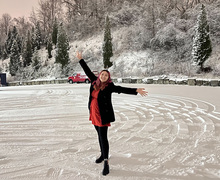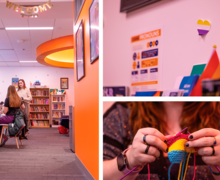Ukrainian revolutionary documents conflict using iPhone photos, videos
Klementia Dymyd was overlooking Kiev’s Independence Square from a nearby rooftop when three bullets barely missed her, hitting the metal roof she was standing on instead.
“Some person tried to shoot me when I was taking pictures from the roof, but there was a strong wind and I think that’s why he didn’t hit me,” said Dymyd, a 21-year-old student from Lviv, Ukraine. “Like three times he tried.”
Dymyd was attending the Ivan Franko National University of Lviv when she quit school to travel to Kiev and participate in EuroMaidan, a three month-long protest during the Ukrainian “Revolution of Dignity” that left 90 people dead. Exactly one year ago, Dymyd use her iPhone to document the nightmarish death and destruction that evolved in Ukraine as a result of tensions with the pro-Russian government. Those images are now on exhibit at Light Work, a local nonprofit photography organization.
“Last year, it was real hard times for Ukraine because our president wanted to destroy Ukraine by signing some agreement with Russia,” Dymyd explained, referring to the Eurasian Customs Union’s attempt to prolong Russian control over Ukraine.
• • •
Dymyd, who goes by Clem, was brought to Syracuse University as a visiting artist in mid-January on behalf of area professors Lida and Mišo Suchý, the Department of Transmedia, Light Work, the Slutzker Center for International Services and the S.I. Newhouse School of Public Communications, said Mišo, a transmedia professor in the College of Visual and Performing Arts.
A handful of Dymyd’s photos are currently on display at Light Work, located within the Robert B. Menschel Media Center, at the rear of Watson Hall. A video story she created, “iStory,” has also been uploaded to video-sharing website Vimeo.
When Lida was in Ukraine as a Fulbright scholar and artist last summer, she was shown Dymyd’s photos from EuroMaidan while visiting with Dymyd’s family in Lviv. Because of Lida and Mišo’s connection to Light Work as former artists-in-residence and art media educators, they were able to suggest a pop-up exhibition with the community darkroom.
“I saw her work and I knew it was something incredible,” said Lida, an adjunct instructor at Onondaga Community College. She had known Dymyd’s mother and family prior to seeing Dymyd’s photographs of EuroMaidan.
In an email to Mišo about Dymyd’s story, Lida wrote: “She was right in the thick of things. I was amazed by her work. Images from above and behind the police lines, images of police and Berkut (special police forces) going after people. Images of Maidan people storming a building where police were. Lots of injured and dead Maidan people.”
• • •
Dymyd said she wasn’t afraid while she was in Kiev, likely because of the constant adrenaline rush. She said she is naturally adventurous, scaling buildings and bridges in her free time.
But she is more upset looking back, having never expected to witness a tragedy of such magnitude.
“A lot of people were injured because police were using rubber bullets and a lot of grenades and tear gas grenades,” Dymyd said as she pointed out different images from EuroMaidan. Her own photographs of smoke surrounding the Berkut, of bloodied protesters, of burning buildings hung in front of her in on an — otherwise blank — wall inside Light Work.
Police would also spray water at protesters, but since it was below 10 degrees Fahrenheit, the water would freeze on their bodies, Dymyd said. Police would also burn buildings that protesters were sleeping in, and the Berkut surrounded protesters so that the injured couldn’t reach hospitals.
“People were trying to use bicycle helmets and ski helmets but really it doesn’t help a lot,” Dymyd said. “But then (the police) just started to use lethal weapons — real bullets.”
On Feb. 20, 2014, after months of conflict, snipers began to shoot protesters, Dymyd said, and 90 people were killed that day.
As she recalled being shot at while she was on top of a building, Dymyd gestured to a photo of a tin roof with multiple bullet holes in it.
• • •
Dymyd could only capture scenes of the revolution on her iPhone.
“She mentioned that she couldn’t have walked around with a (single-lens reflex) camera, or she would have been shot,” said John Mannion, Light Work’s master printer. Mannion helped Dymyd edit and print her image files at Light Work’s lab facility.
Mannion said that after seeing the images Mišo and Lida brought to his attention, exhibiting Dymyd’s photos was the best way to support her.
“For us — for this place — Clem’s work is an example of the way we like to support artists,” Mannion said. “There really wasn’t a second thought to giving her space and printing her work. Clem’s pretty amazing — she’s pretty heroic.”
Dymyd has been working on her photos as a visiting artist at Light Work since her arrival last month. She’s been giving several artist talks and presentations at Light Work and around SU.
“Really, the idea was that the person at the age of our students bring the experience of young people in Ukraine,” Mišo, the transmedia professor, said. “It is the very best when young people talk to young people. We wanted to bring the young Ukrainian to talk with the young Americans.”
Although it’s been exhausting, Dymyd said she appreciated being able to give presentations about her experiences and the changes her country is undergoing. On Thursday, she will be presenting her images and talking about her time in Kiev from 6:30 p.m. to 8 p.m. in Kittredge Auditorium in Huntington Beard Crouse Hall.
“It’s a hard thing to articulate what it is to make these prints look good,” Mannion said. “The way that one deals with that artistically is hoping that there’s a way to speak about a difficult situation.”
Violent Russian involvement in Ukraine still wages on to this day. The total brutality of the regime and the horrible situation require sacrifice from young people like Dymyd to turn despair into something that will move the country forward, Mišo said.
“I hope out of this tragedy and pain, a new Ukraine will be born,” Mišo Suchý said. “It is people like her, who are honest and brave, that give me hope.”
Published on February 19, 2015 at 12:01 am







